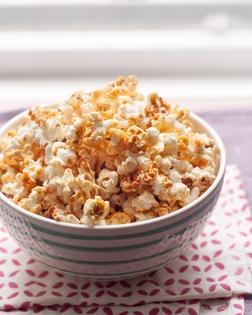THE KITCHN: How to make kettle corn at home
If your nose doesn't lead you straight to the kettle corn vendor at just about any state fair or festival, then your ears surely will. The aroma of lightly caramelized popcorn combined with the merry sound of popping is all the encouragement I need to buy myself a big bag for snacking. Craving this sweet and crunchy treat without the road trip? Here's how you can make kettle corn at home.
In the pantheon of popcorns, kettle corn sits somewhere in between plain popped corn and caramel corn. It's lightly golden -- more or less so depending on the amount of sugar you use -- and salty-sweet. It has a crisp crunch from the sugar coating, but won't stick to your teeth the way caramel corn sometimes does. Kettle corn also takes significantly less time than full-on caramel corn since it's made entirely on the stovetop -- it's a quick five-minute snack right when you need one.
And you most definitely do want to make it on the stovetop. The secret to kettle corn, both at the state fair and at home, is letting the sugar caramelize just a bit over direct heat as the popcorn pops. You just can't imitate that rich flavor in the microwave -- or with commercial microwave popcorn!
To avoid burning the sugar and to get every piece of popcorn coated with sugar, keep shaking that pan as the popcorn pops. Also, don't be tempted to wait until every kernel has popped; remove the pan from heat as soon as popping slows. You'll end up with more unpopped kernels, but it's worth it to avoid scorching the whole batch. This said, you'll always get a few burnt pieces in the bunch -- just pick them out and carry on snacking.
Kettle corn has become my new favorite afternoon treat. It's also easy to pack up and tuck in your bag for an easy snack on the go.
Kettle Corn
Makes 6 to 8 servings (About 10 cups).
3 tablespoons oil, like coconut oil, canola oil, or other vegetable oil
1/2 cup corn kernels
1/4 to 1/2 cup white granulated sugar, to taste
1 teaspoon salt
Equipment:
Baking sheet
Parchment paper
4-quart sauce pot with lid
Long-handled spoon for stirring
Line a baking sheet with parchment and set it near the stove. You will pour the popped corn out onto this sheet to cool.
Pour the oil into the pot and drop three kernels of corn over the top. These three kernels will be your indicator for when the oil is hot. Cover with the lid and set over medium-high heat.
When you hear one of the kernels pop, uncover the pot and pour in the rest of the kernels, sugar and salt. Use 1/4 cup of sugar if you like slightly sweet kettle corn and more if you like sweeter. Quickly stir everything together to coat all the kernels and replace the lid.
Shake the pan occasionally as the popcorn starts to pop, and then more frequently and vigorously as the popping increases. Rest the pot on the burner every few seconds to maintain the heat.
Some wisps of steam toward the end of popping are normal -- don't confuse this with smoke! However, if you smell smoke, stop popping and proceed with the next steps.
Listen closely -- when you hear the popping begin to slow, 1 to 2 seconds between pops, remove the pan from heat. Don't wait for every kernel to pop or you'll end up burning the popcorn; as soon as you think it might be starting to slow down, take it off the heat. Total popping time is about 2 to 3 minutes on my electric stove.
When the popping slows, immediately uncover the pot and pour the popcorn on the prepared baking sheet. Use the long-handled spoon and your fingers to spread the popcorn into an even layer to cool and pick out any burnt pieces (there are always a few in every batch!).
Let the kettle corn cool for at least five minutes -- the popcorn will crisp as it cools. Eat immediately or store in an airtight container for several days.
Note:
Using other sugars: Kettle corn is usually made with plain old white granulated sugar, but this shouldn't stop you from experimenting! Try any other granulated sugar, like turbinado or muscavado, or experiment with liquid sweeteners like honey and maple syrup.
(Emma Christensen is recipe editor at TheKitchn.com, a nationally known blog for people who love food and home cooking. Submit any comments or questions to kitchn@apartmenttherapy.com.)







